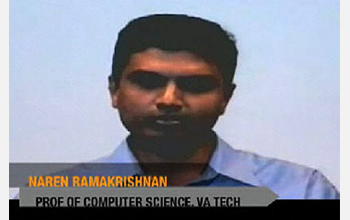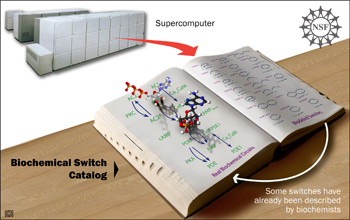|

All Images

Discovery
Finding the Switches to Our Cells' 'Computer'

Back to article | Note about images
 |
A computer-generated image showing the "family" of switches that Ramakrishnan and Bhalla discovered in their study. In addition to discovering over 4,000 chemical switches in cells, the researchers also learned that the switches themselves are related, as this diagram shows. This may offer an explanation as to how cells evolved the ability to use more complex switches.
Credit: Courtesy of Naren Ramakrishnan and Upinder S. Bhalla |
Download the high-resolution JPG version of the image. (470 KB)
|
Use your mouse to right-click (or Ctrl-click on a Mac) the link above and choose the option that will save the file or target to your computer.
|
 |
 View video View video
An interview with Naren Ramakrishnan, a professor of computer science at Virginia Tech, about his research into chemical switches in cells. With the aid of supercomputers, researchers have been able to model the interaction of thousands of groups of molecules that behave as switches. Each set of interactions reads almost like an electrical circuit. They have generated a hefty catalog of possible biochemical switches. Each switch involves at least three molecules. Remarkably, some of the modeled circuits have already been identified and described by biochemists in real biological circuits.
Credit: Video - Virginia Tech and National Science Foundation
Still - Naren Ramakrishnan, Virginia Tech
|
 |
With the aid of supercomputers, researchers have been able to model the interaction of thousands of groups of molecules that behave as switches. Each set of interactions reads almost like an electrical circuit (right). They have generated a hefty catalog of possible biochemical switches. Each switch involves at least three molecules. Remarkably, some of the modeled circuits have already been identified and described by biochemists in real biological circuits (left).
Credit: Zina Deretsky, NSF |
Download the high-resolution JPG version of the image. (916 KB)
|
Use your mouse to right-click (or Ctrl-click on a Mac) the link above and choose the option that will save the file or target to your computer.
|
|




